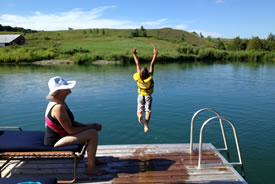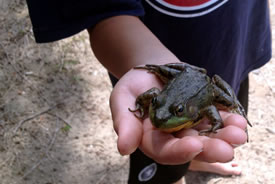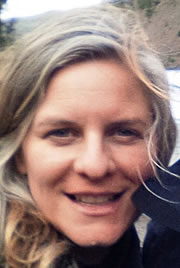Gone swimming: There may be more behind water's magical allure than we think

Katie Redux (Paiting by Elizabeth Lennie, http://www.elizabethlennie.com)
Water compels me.
There’s nothing like the sensations accompanying a dive into the deeps of a fresh water lake, wading out from the ocean’s shore into an unbroken horizon of blue or dunking off the dock’s edge into the dark wind-broken water in the evening.
Getting in, getting wet is rarely a bad idea.
I have made a lot of life decisions around proximity to water. The needle of my personal compass has always been pulled by liquid landscapes. Growing up along the banks of the St. Lawrence River in eastern Ontario, the river formed the south side of my life for 18 years; an open, moving border rich with history, motion and impermanence. When it came time to leave for university, accessible waterfront was part of my criteria for a new home. I moved west, just beyond where the St Lawrence becomes Lake Ontario, past 1000 islands to Kingston, where places like Wolfe Island or Frontenac Provincial Park are easy to get to and the swimming is grand.

Si at the pond (Photo by Erica Thompson/NCC staff)
From Haida Gwaii on the Pacific coast, to the river rich country of the Niagara Escarpment, the ability to get in, on or around water has been a leading determinant of where I live.
According to marine biologist Wallace J. Nichols, that’s no accident. In his book Blue Mind: The Surprising Science That Shows How Being Near, In, On, or Under Water Can Make You Happier, Healthier, More Connected, & Better at What You Do, Nichols finds that, "water provides the most profound shortcut to happiness out there."
Nichols, in partnership with neuroscientists, artists, poets and biologists, is drawing links between how our brains respond to water — how it soothes us, reduces anxiety and connects us to nature — and the need to conserve and care for it. He calls this bridge between healthy happy engaged people and advancing healthy functioning water habitats neuroconservation.
“Clearly, creating more protection and restoration will require that we better appreciate and understand the science behind, and what goes into the mysterious elixir called inspiration, the chemistry of thrill, and the main ingredient found in soothe,” says Nichols.
According to Nichols’ website, “The early benefits of this inquiry have already influenced public health, education, parenting, business, coastal planning, travel, real estate, sports and recreation, and most importantly restoring and rebuilding our personal, ancient emotional connection with healthy waterways. We expand the ‘ecosystem services’ conversation to include the vast array of cognitive and emotional services, values, and benefits offered by clean, healthy waterways.”
Studies linking the purported healing effects of nature on the contemporary human condition are rapidly surfacing these days and these explorations are not restricted to rural or remote landscapes. Charles Montgomery's Happy City explores factors linked to creating and sustaining happiness for those living lives in urban habitats — the places the majority of the world’s people call home.
“Green space in cities shouldn’t be considered an optional luxury,” Montgomery writes. “It is a crucial part of a healthy human habitat.”
Whether your place is green or blue, there is growing evidence that spending time in nature is not only important but a necessary element of happiness and health. Taking this notion one step further, Guardian UK journalist George Monbiot recently wrote the editorial "An Ounce of Hope is Worth a Ton of Despair," in which he identifies emotions of wonder and hope as rallying points for nature. He writes that familiarity and curiosity will compel us to care for our natural surroundings and engage in active conservation with beneficial outcomes for species and for habitats. Meanwhile, messages anchored in threats, loss and fear lead to paralysis and alienation.

Simon the frog-catcher (Photo by Erica Thompson/NCC staff)
My six-year-old son spends hours searching for turtles and frogs along riverbanks. He spends hours climbing up onto an anchored raft only to launch back in —a swimmer’s game of speed, distance and quality of splash. It’s timeless time spent.
For me, I feel deeply calm and content while swimming in vast Georgian Bay, wading into Lake Ontario across the limestone shelves of western Wolfe Island, or dipping into the Madawaska River’s deep dark waters. I make time to put myself in these places because like a weight on an old-fashioned scale, these places, these moments balance the rest of them.
Floating under sky, buoyed by the delicate expanse of my own weight, moved by ripple or wave, my mind is still and I savour the sweetest of summer moments; grateful for such places.
Visit the Nature Conservancy of Canada to find out what we are doing to protect fresh water and marine habitats by searching for "water."


